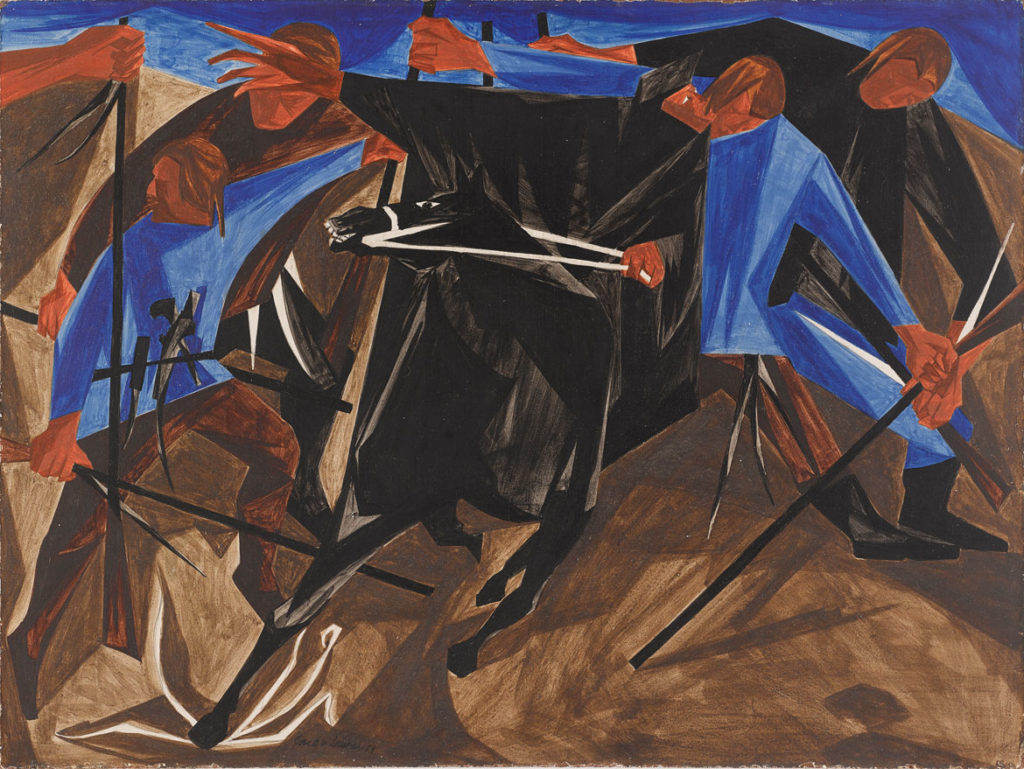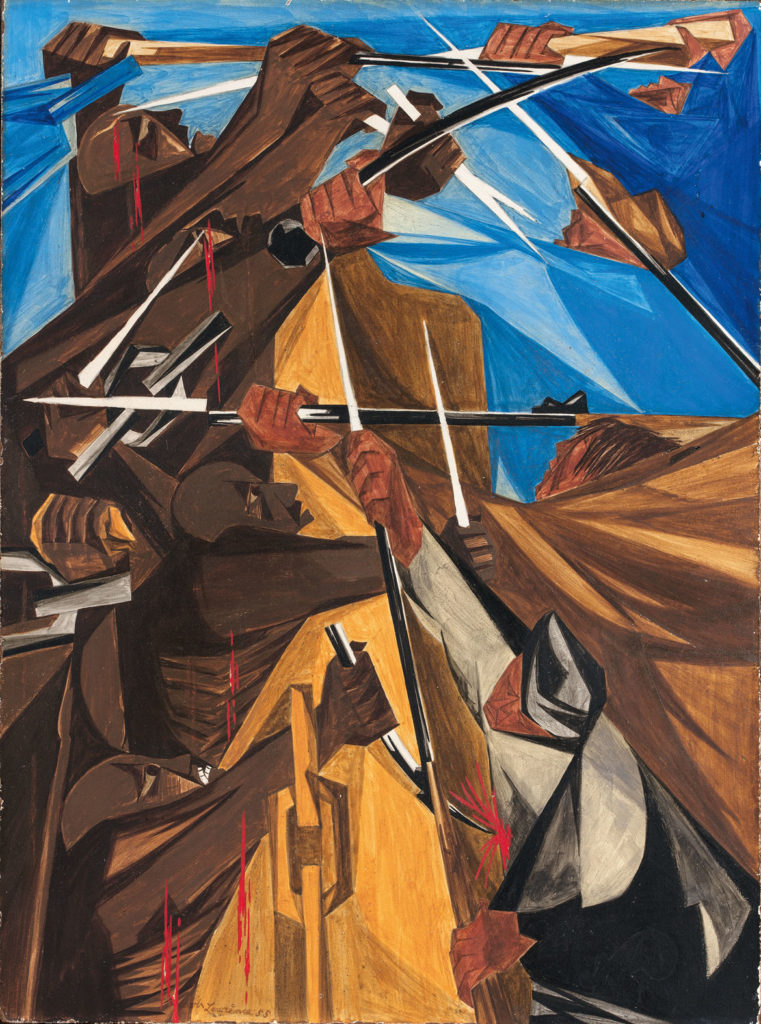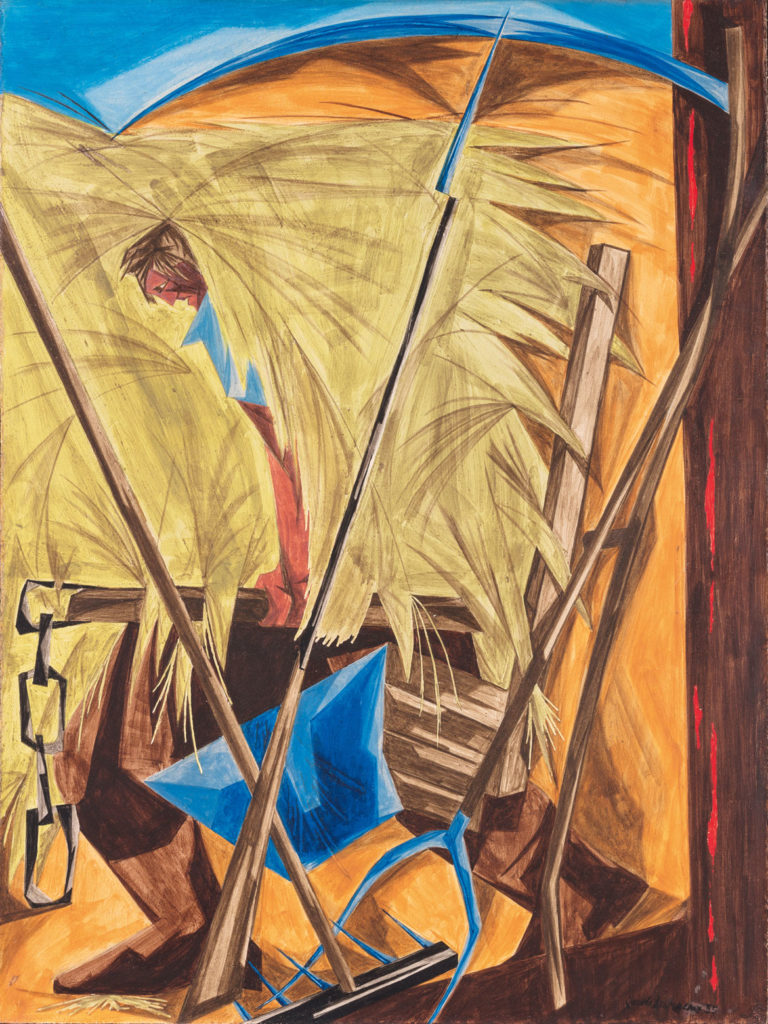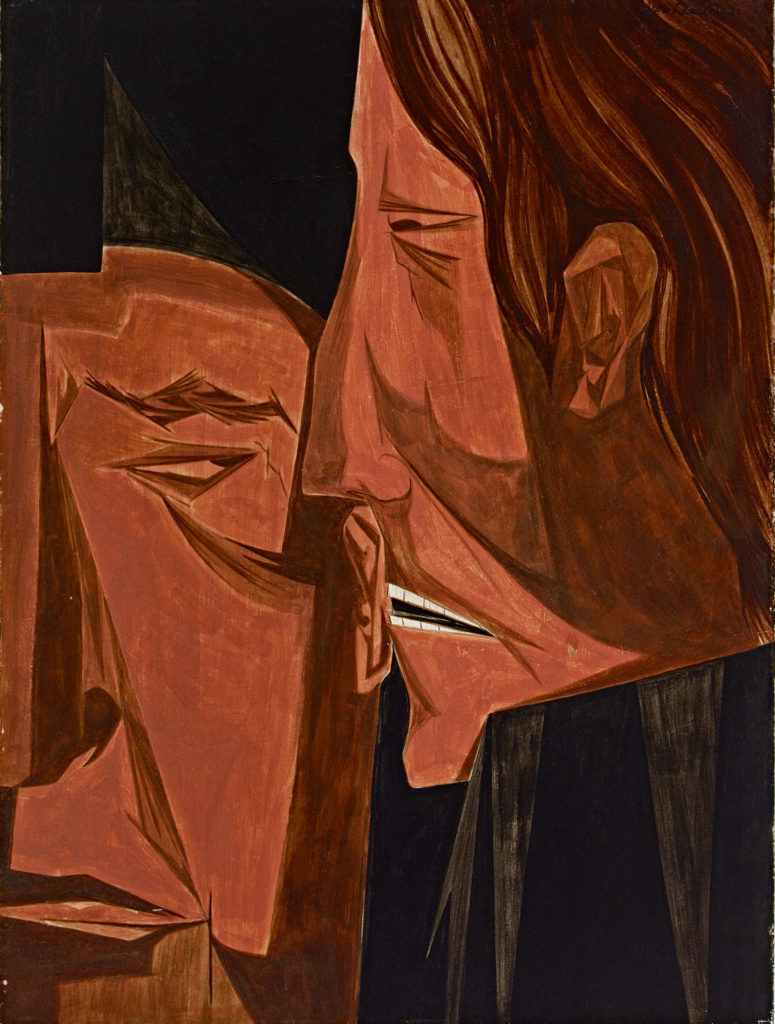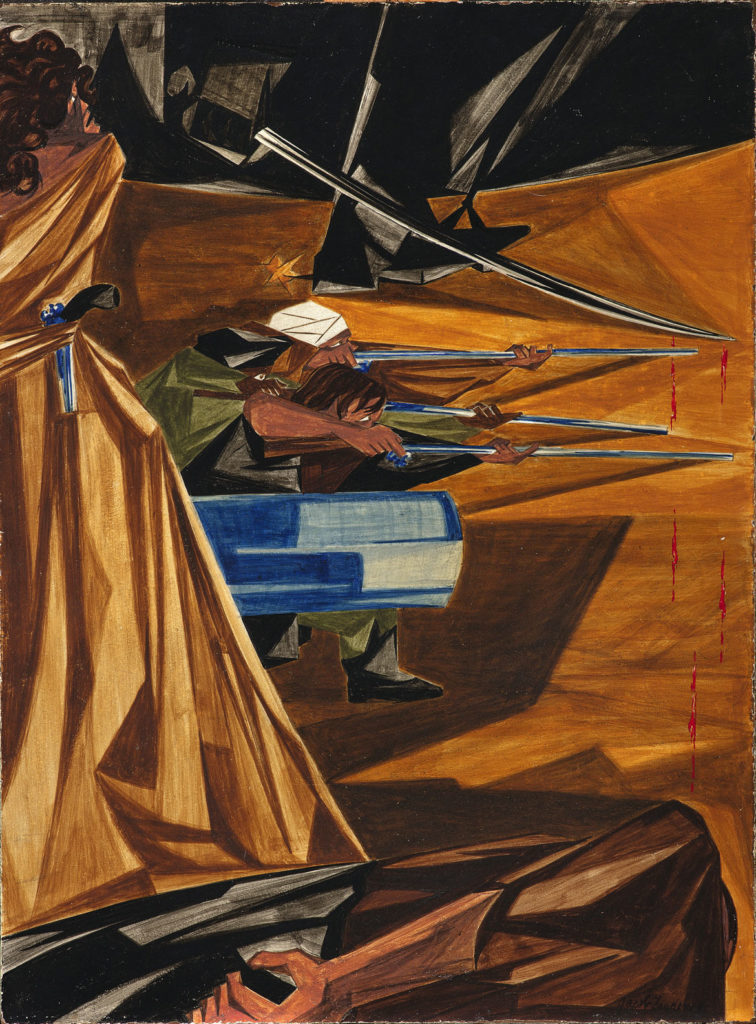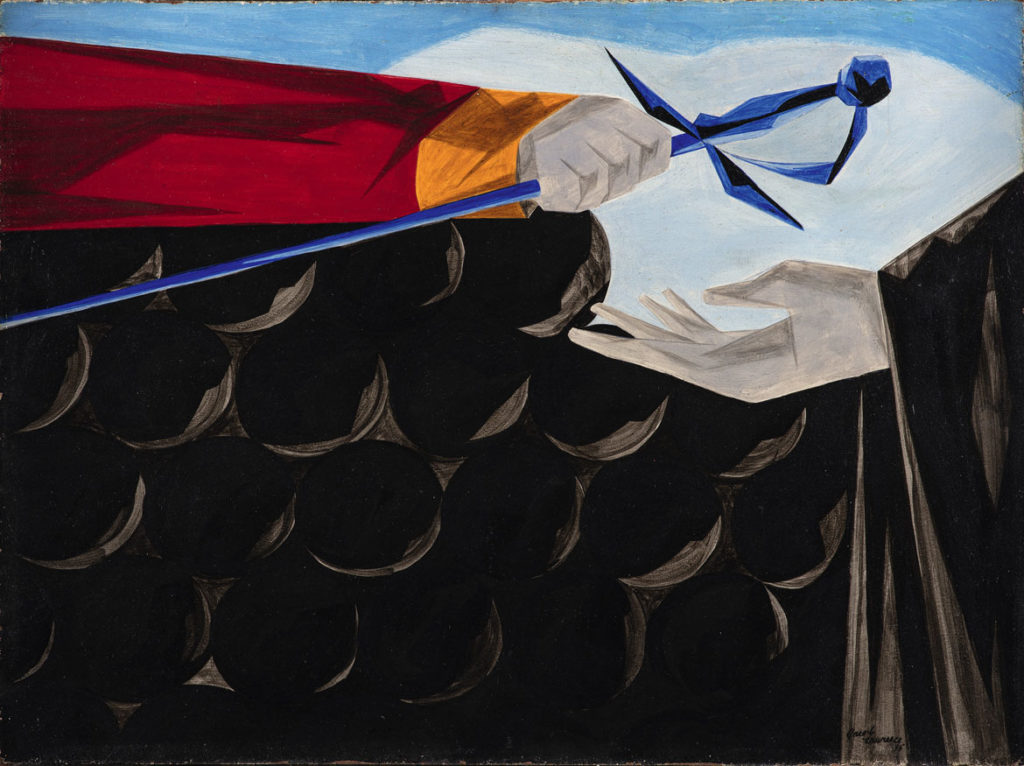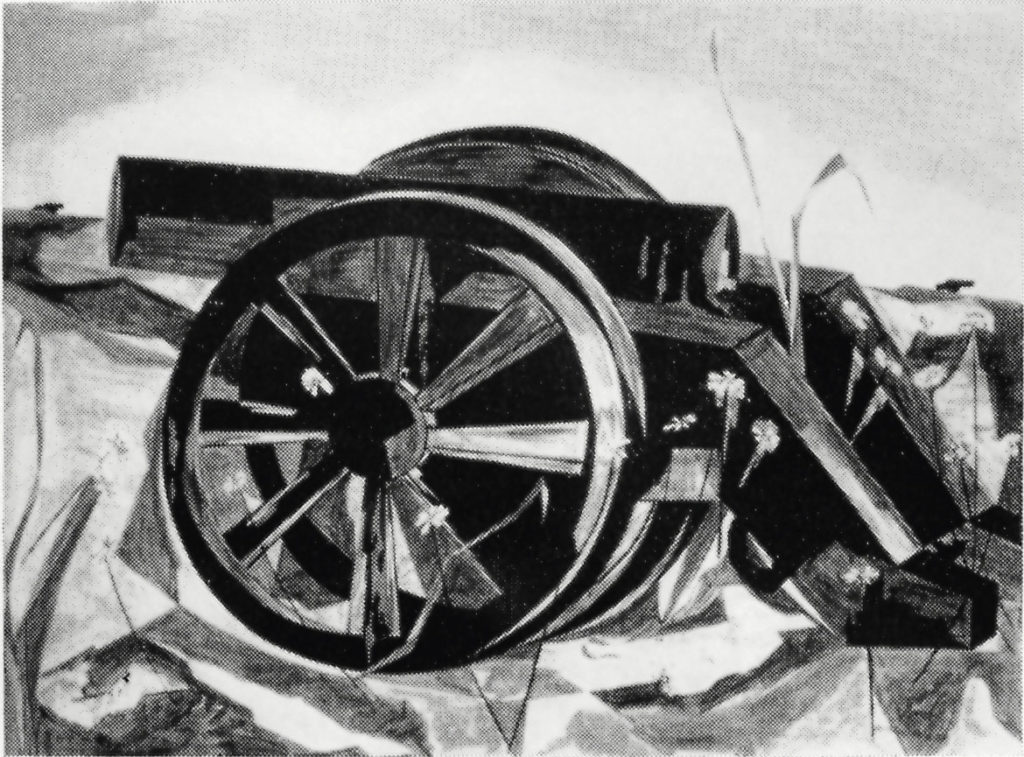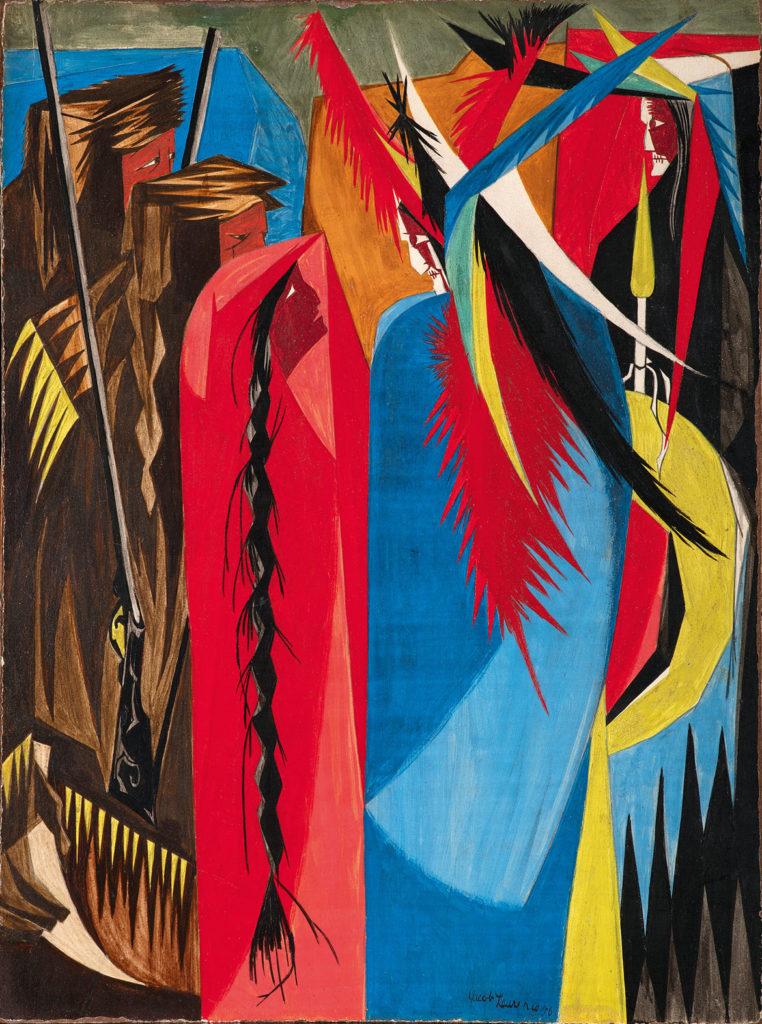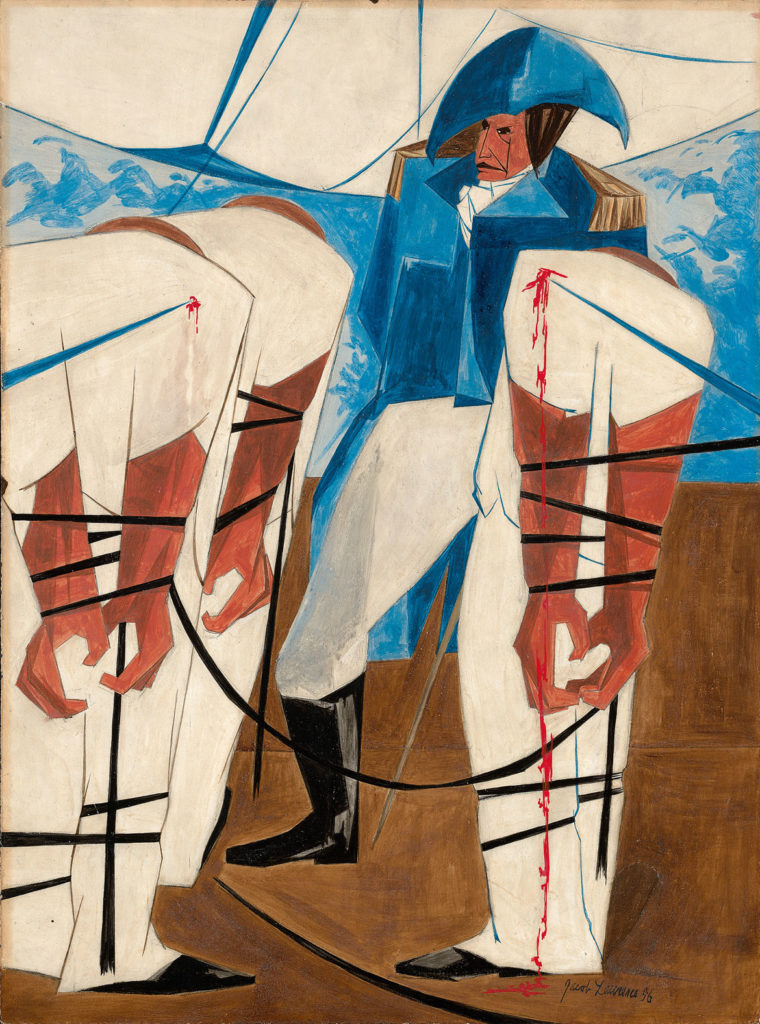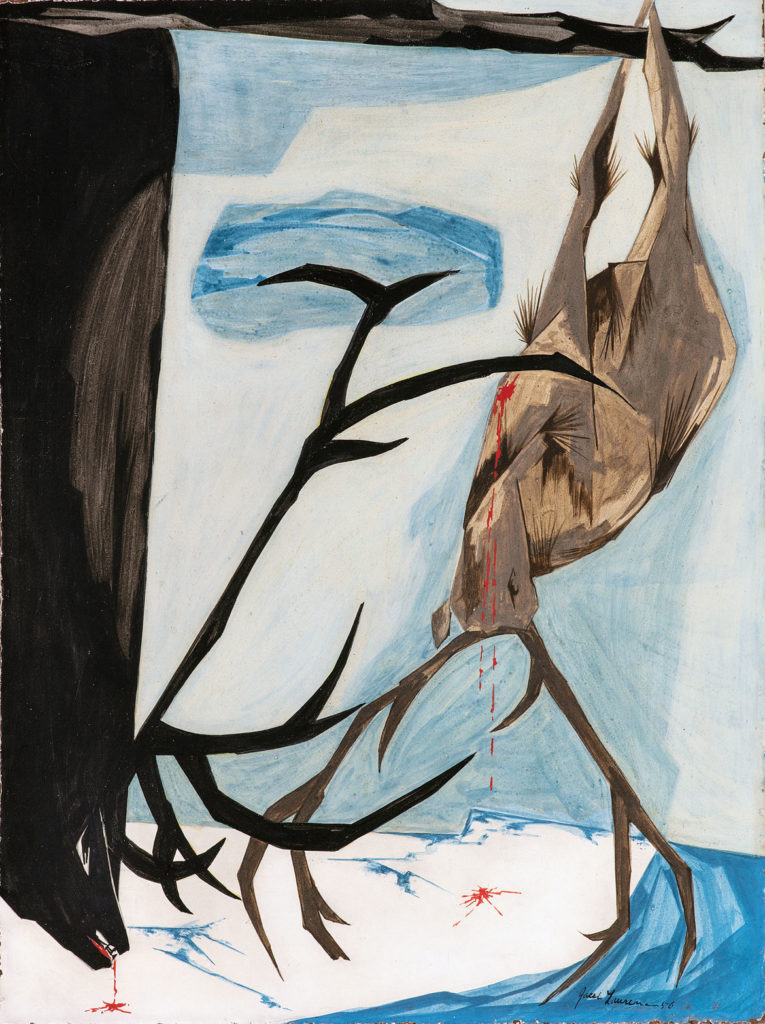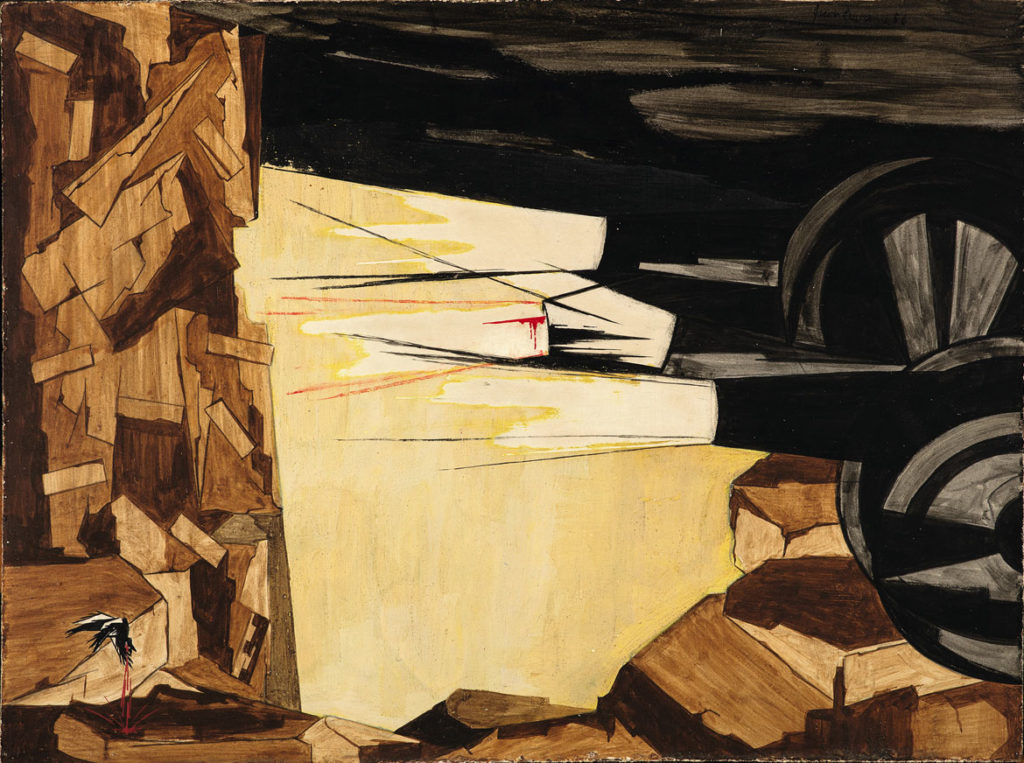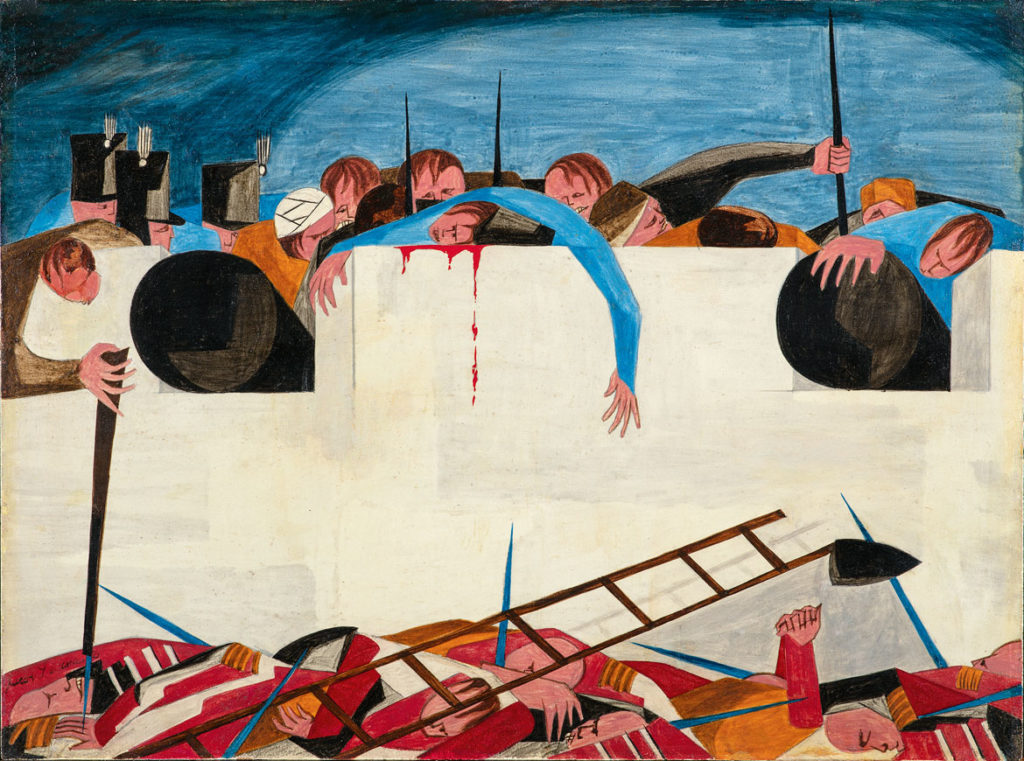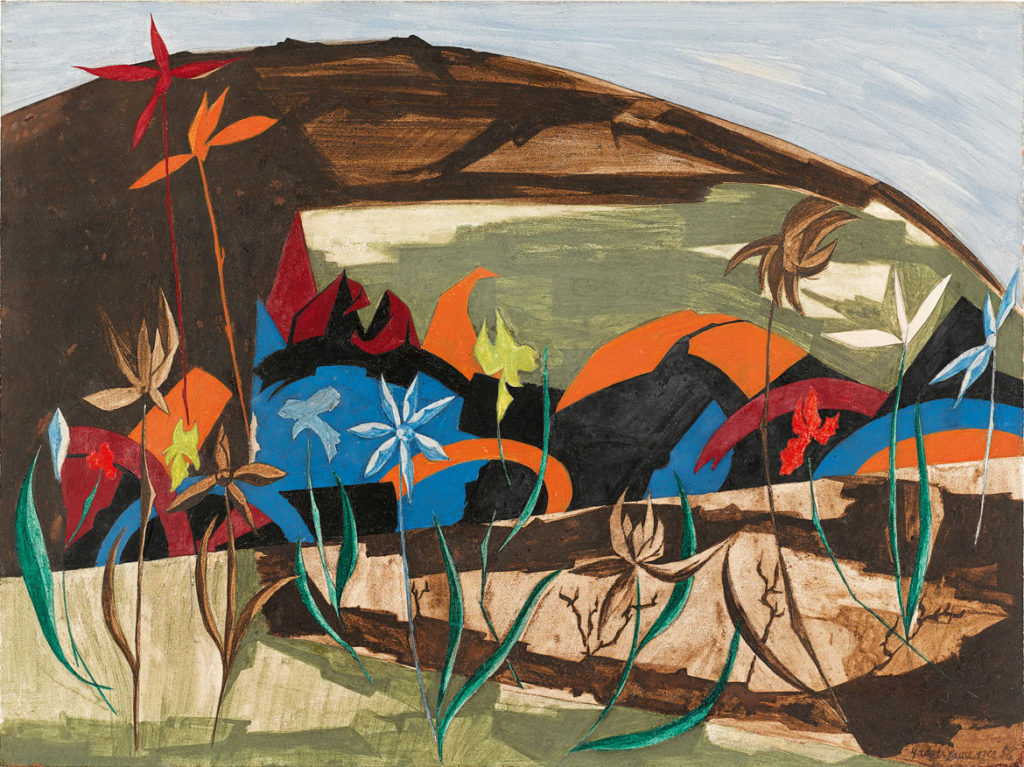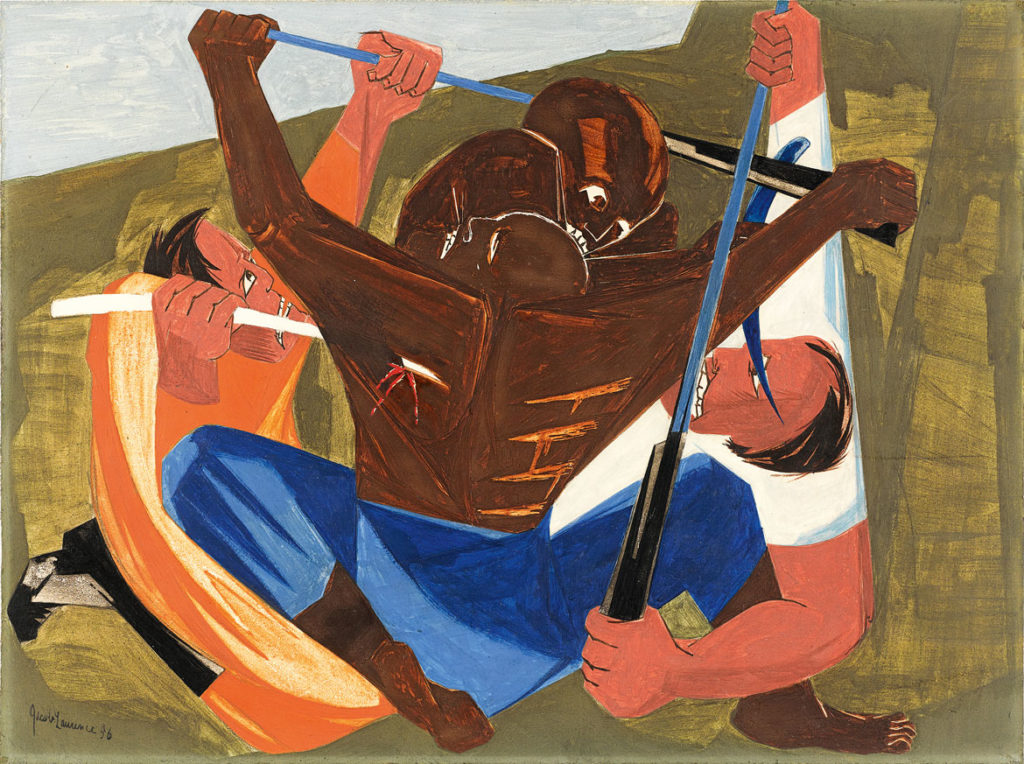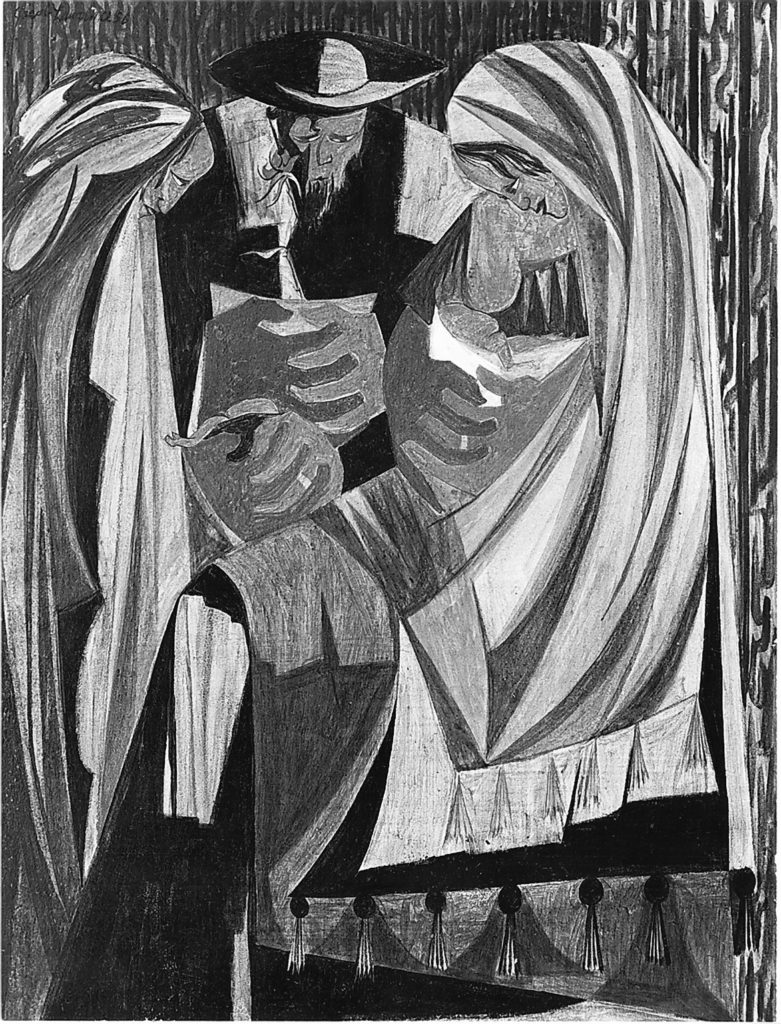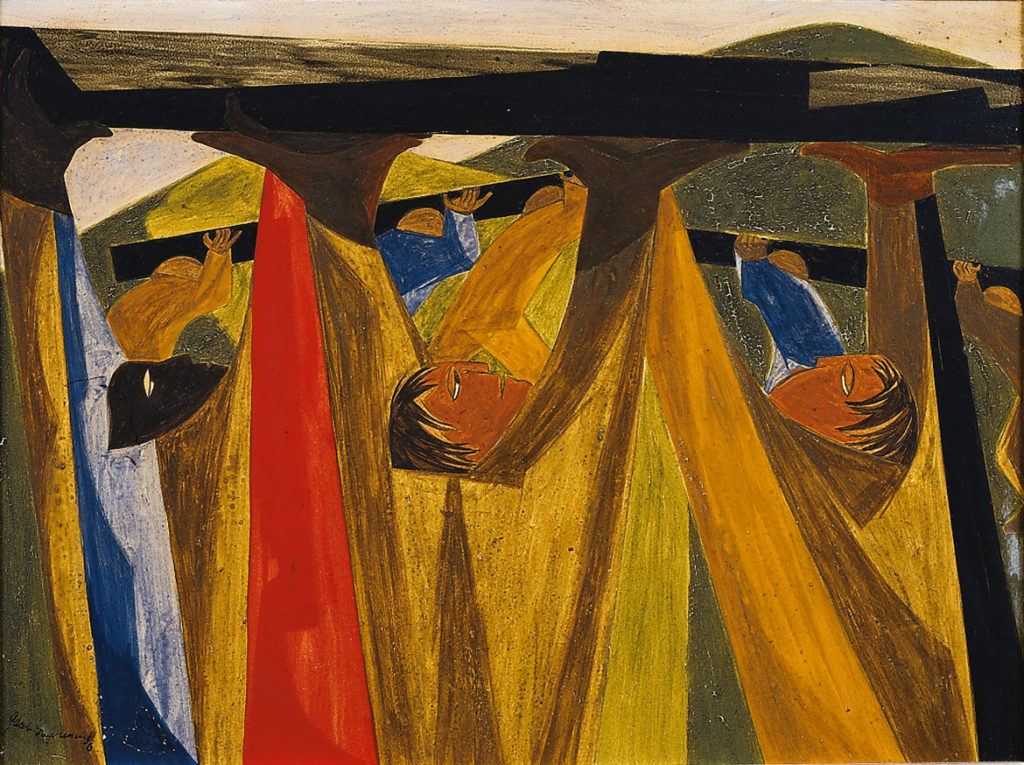In February 1953, Time magazine declared Jacob Lawrence “the nation’s (and probably the world’s) foremost Negro painter.”
Lawrence was about to embark on what he intended to be a monumental “series of paintings relating the history of the Negro people in the United States,” as he wrote in a December 1954 application for funding from the Chapelbrook Foundation.
He hoped that his paintings would “serve in some small way to further enlighten those who come in contact with them of the struggles, contributions, and ingenuity of the American people.”
But as Lawrence developed his plan, he came to believe his idea was too narrow. It shouldn’t be just Black history, it should be a broad history of America with African Americans’ roles integrated into it. It should be the American story reflecting all the diverse contributions.
That series, “Struggle: From the History of the American People,” reunited for the first time in more than 60 years, is on view in the exhibition “Jacob Lawrence: The American Struggle” at Salem’s Peabody Essex Museum from Jan. 18 to April 26, 2020. (The exhibition is augmented by work from three contemporary artists: Hank Willis Thomas, Derrick Adams and Bethany Collins.)
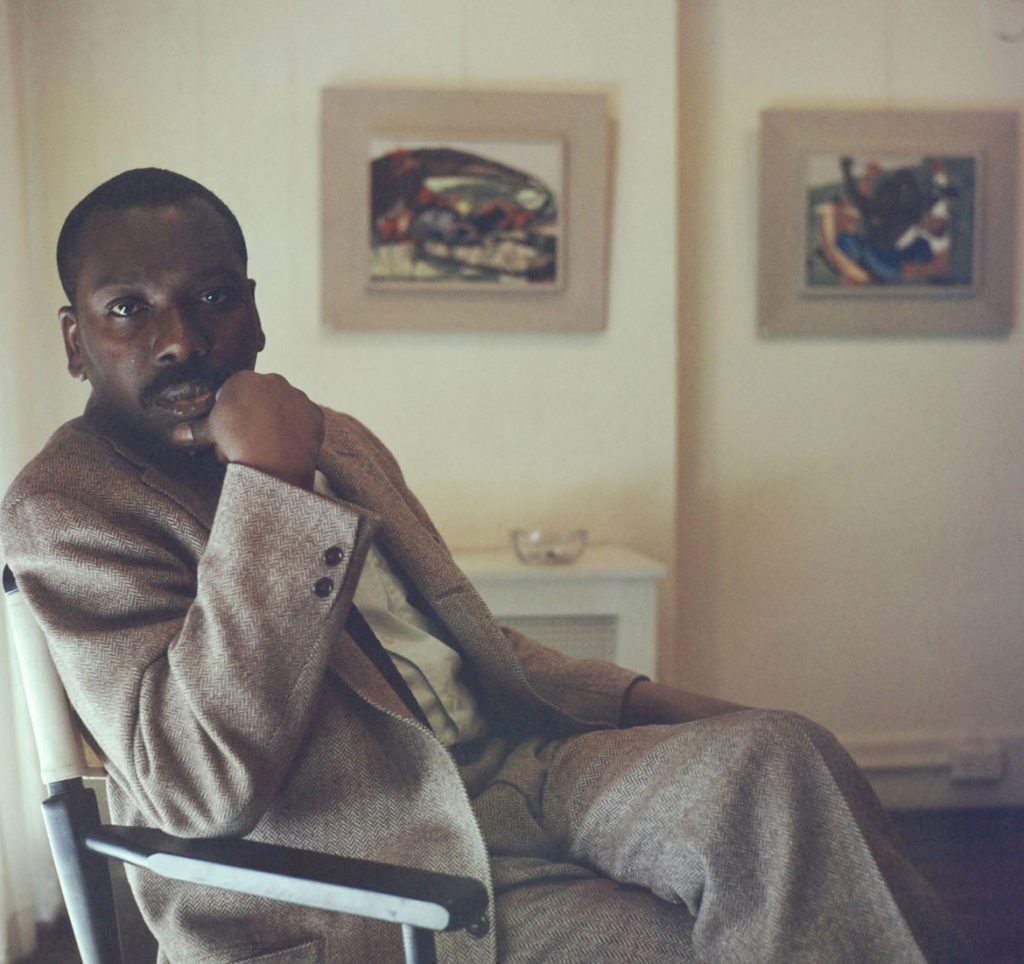
One of the principal projects of African American artists in the 20th century was wresting control of their image and story from racist white America. And Lawrence was at the forefront of this effort. He had become one of the most prominent chroniclers of Black life by painting, beginning in 1936, a landmark group of narrative series (paintings all devoted to telling one story) about Haitian freedom fighter Toussaint L’Ouverture, American abolitionist Frederick Douglass, American liberator Harriet Tubman, and America’s Great Migration. All along, he also painted stand-alone scenes of African American life in Harlem, where he lived until moving to Brooklyn in 1943.
Lawrence rose to stardom when 26 of his 60 panels depicting of “The Migration of the Negro” from the American South to the North were published in Fortune magazine in 1941. The following year, New York’s Museum of Modern Art and Washington, D.C.’s Phillips Memorial Gallery each bought half of the series, and MoMA sent the series on a 15-venue national tour.
After World War II service in the U.S. Coast Guard from October 1943 to December 1945, he painted his series “War.” In 1947, the photographer and Fortune magazine editor Walker Evans commissioned Lawrence to paint Black life in the American South. Lawrence made 10 paintings based on his travels to Vicksburg, Mississippi; Tuskegee, Alabama; New Orleans and Memphis. Fortune published three of them in August 1948.
The following year, Lawrence conceived a series about the history of African Americans that would become “Struggle.”

If this is the kind of coverage of arts, cultures and activisms you appreciate, please support Wonderland by contributing to Wonderland on Patreon. And sign up for our free, weekly newsletter so that you don’t miss any of our reporting.
‘Nervous Difficulties’
Lawrence began, as he often did, with research at the Division of Negro Literature, History and Prints, a special collection of the 135th Street Branch of the New York Public Library (now the Schomburg Center for Research in Black Culture).
But before Lawrence made much progress, in July 1949, he checked himself into Hillside Hospital in Queens, New York, suffering from what has been variously described as depression or a nervous breakdown. He remained at Hillside for four months, until November. In January 1950, he returned to Hillside for seven more months.
“Lawrence simply had nervous difficulties neither particularly complicated nor unique, which became so much of a burden that he voluntarily sought help,” his doctor at Hillside told The New York Times in 1950 as Lawrence prepared for an exhibition of paintings he’d made of life in the mental hospital.
“Lawrence has captured the frenzied absorption of patients seeking release from tension in weaving and gardening (occupational therapy) and the concentration of those haltingly uncovering dark secrets (psychiatric therapy),” Aline B. Louchheim wrote in the Oct. 15 New York Times. “…While he was at Hillside Lawrence read Walt Whitman. Now he wants to see more of the poet’s America. Eventually he will document that America too.”
The following year, inspired in part by seeing a lot of theater, Lawrence started painting stand-alone scenes on the theme of “Performance”—images of concerts, a ventriloquist, strong men, a magician, marionettes, Black Vaudevillians. After more than a decade of ambitious investigations of Black life, Black heroes and racism; after service in World War II; after a tour of the segregated South; after months in a mental hospital; Lawrence may have been taking a step back and using these paintings of performers to mull the purpose of art, to reconsider his direction as an artist.
Meanwhile, the U.S. government had begun to see Lawrence as a danger because of his championing of Black folks. In January 1953, a month before Time magazine’s praise, the FBI began assembling a file on Lawrence. That June, the U.S. State Department issued a classified memo declaring Lawrence a “potential security risk” for perceived links to communism. In August, a secret four-page FBI report alleged that Lawrence had “subversive” ties to arts groups that the Bureau accused of being fronts for Communist Party efforts to recruit Black people by using art to “propagandize alleged acts of racial discrimination of Negroes.”

‘All The Peoples’
Lawrence originally envisioned “Struggle” would total 80 pictures beginning with the “landing of Captain Christopher Newport on Chesapeake Bay in 1706 and end with the armistice of World War I on November 11th 1918,” according to his January 1954 application for a Guggenheim Foundation grant.
But when he applied for funding from the Chapelbrook Foundation in December 1954, Lawrence wrote: “As I read more of the history of the United States, I gradually began to appreciate not only the struggles and contributions of the Negro people, but also to appreciate the rich and exciting story of America and of all the peoples who emigrated to the ‘New World’ and contributed to the creation of the United States. … So it seems that this project has ceased to be the story of the Negro people in America and become the story of the American people.”
“I wanted to show in doing it how the Negro had participated and to what degree the Negro had participated in American history,” Lawrence recalled in a 1968 oral history interview for the Smithsonian’s Archives of American Art. “…In the 1950’s the Negro had not been included in the general stream of American history. … Up till now he’s been taken out, just excluded, or put aside. We don’t know the story, how historians have glossed over the Negro’s part as one of the builders of America, how he tilled the fields, and picked cotton, and helped to build the cities. Now I don’t want to be sentimental and say well the Negro did all this, the Negro did nine-tenths of this. This wouldn’t be true either. I mean there were many other groups coming from Europe who contributed. However, these other groups always get mentioned. The Polish, the Italians, the English, they’re all mentioned as to their contributions. When I was a child this is all I heard of. All we hear of the American Negro is that he picked cotton. And they don’t even call it a contribution.”
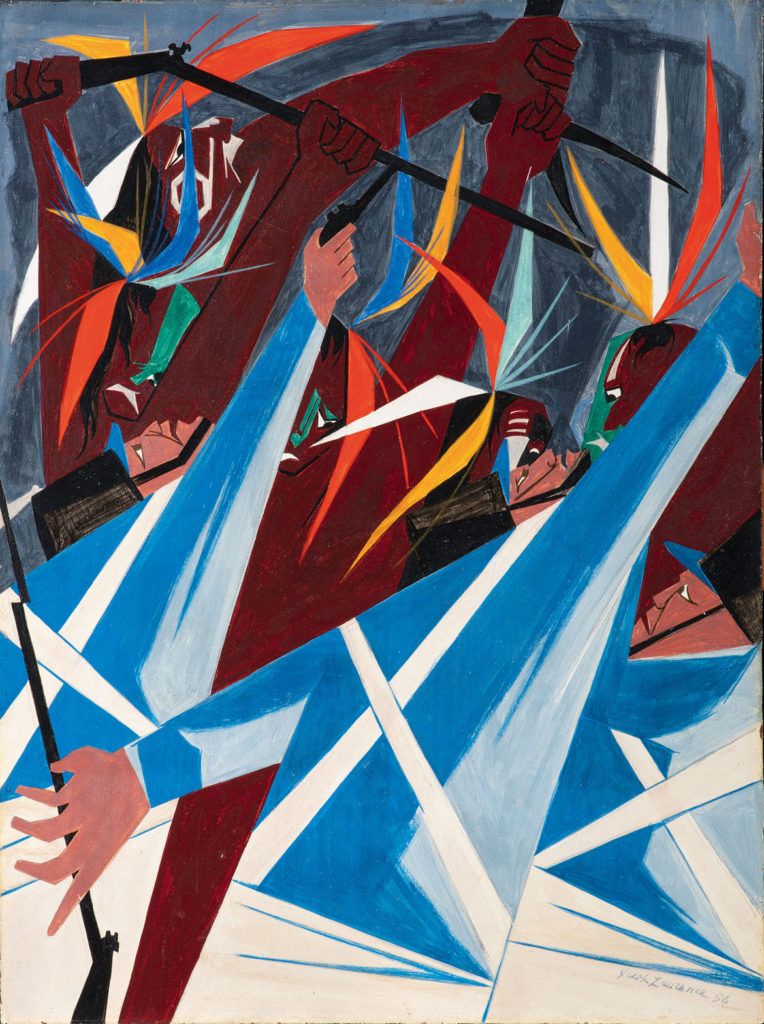
Lawrence began painting “Struggle” at Yaddo, an artist residency program in Saratoga Springs, New York, where he went for a three-month fellowship starting in May 1954. “The paintings which I propose to do will depict the struggles of a people to create a nation and their attempt to build a democracy,” he wrote to the Chapelbrook Foundation that December. “This work will begin with the causes and events leading into the American Revolutionary War and end with the sailing of the American Fleet around the world in 1908. Between these two events will be depicted the great migration westward which occurred during the greater part of the nineteenth century, and incidents leading up to and including the Civil War and the Industrial Revolution.”
Lawrence’s American history is violent, bloody, guns and bayonets. He began painting the “Struggle” series with scenes like Paul Revere’s ride and George Washington crossing the Delaware River.
“There are Negroes with Washington crossing the Delaware purposely so because I wanted to show how he was so much a natural part of the American experience,” Lawrence recalled in a 1968 oral history interview for the Smithsonian’s Archives of American Art. “…This was not a Negro series. It isn’t just Negroes. It dealt with Washington crossing the Delaware, Negroes who where with Washington when he crossed the Delaware. Not as slaves. These people were people who had signed up to take part in the American Revolution.”
By the end of 1954, Lawrence had completed seven “Struggle” paintings in egg tempera on board, each 12 inches by 16 inches. According to his December letter to the Chapelbrook Foundation, he had scaled back his plans for the series. Now it would be just 60 paintings.
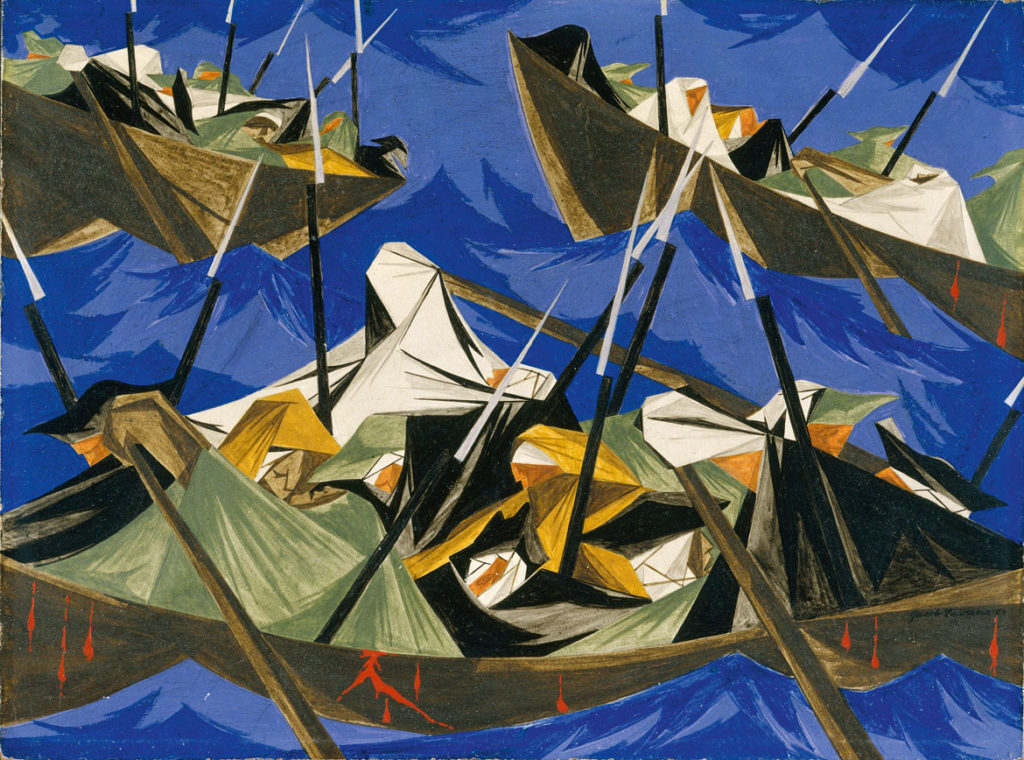
‘Prophesy’
“The history of the United States fascinates me. Right now, I’m reading it, looking for any episode that suggests a symbol of struggle,” Lawrence told critic Selden Rodman in 1956. “The part the Negro has played in all these events has been greatly overlooked. I intend to bring it out.”
Lawrence drew inspiration from 19th century history painting as well as books: Carl Van Doren’s 1941 “Secret History of the American Revolution”; Charles A. Beard and Mary R. Beard’s 1944 “A Basic History of the United States”; Roger Butterfield’s 1947 “The American Past: A History of the United States from Concord to Hiroshima, 1775–1945”; Alan C. Collins’s 1953 “The Story of America in Pictures”; Richard B. Morris’s 1953 “Encyclopedia of American History”; Langston Hughes’s 1954 “Famous American Negroes.”
“I have also, about three-hundred items and pictures which I have clipped from newspapers and magazines and, which I am using as reference material for this project,” Lawrence wrote in his Chapelbrook application. Including reports on the 1954 Supreme Court school desegregation decision in Brown v. Board of Education and the 1955 to ’56 Montgomery bus boycott.
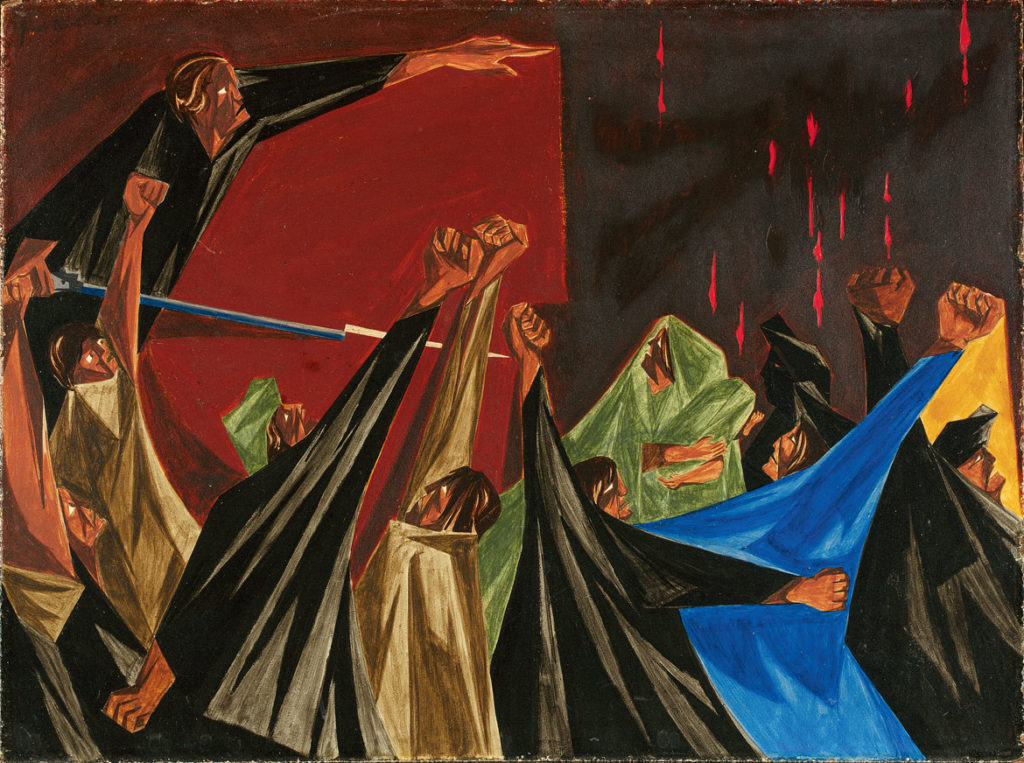
Each of the “Struggle” paintings has a title and then a quotation drawn from political speeches, letters, diaries, military reports, an enslaved man’s petition for freedom. As Lawrence arranged the sequence of the paintings, the first one in the story became Patrick Henry’s rallying speech to the Virginia Convention in March 1775—which is infused with Lawrence’s questioning of the hypocrisy of slave owners fomenting a revolution for liberty: “. . . is life so dear or peace so sweet as to be purchased at the price of chains and slavery?” On the back of the panel, Lawrence wrote the title “Protest.” But he came to rename it “Prophesy.”
“Struggle” offers narrative paintings in the tradition of social-justice murals (Lawrence as a particular fan of Mexican painters José Clemente Orozco, Diego Rivera, David Alfaro Siqueiros) or photography documenting the 1930s Depression or Stations of the Cross. The compositions are Modernist, flat and graphic, angular, jagged, knife sharp. Lawrence tended to stick with a limited palette of colors, often using them unmixed so they would match across the span of a series. His hues include brown, blue and white plus red, black and green that can evoke the Black nationalist flag created in 1920 for Marcus Garvey’s Universal Negro Improvement Association and African Communities League as wall as green, yellow and red that can bring to mind the pan-African colors taken up by African anti-colonial movements in the mid 20th century.
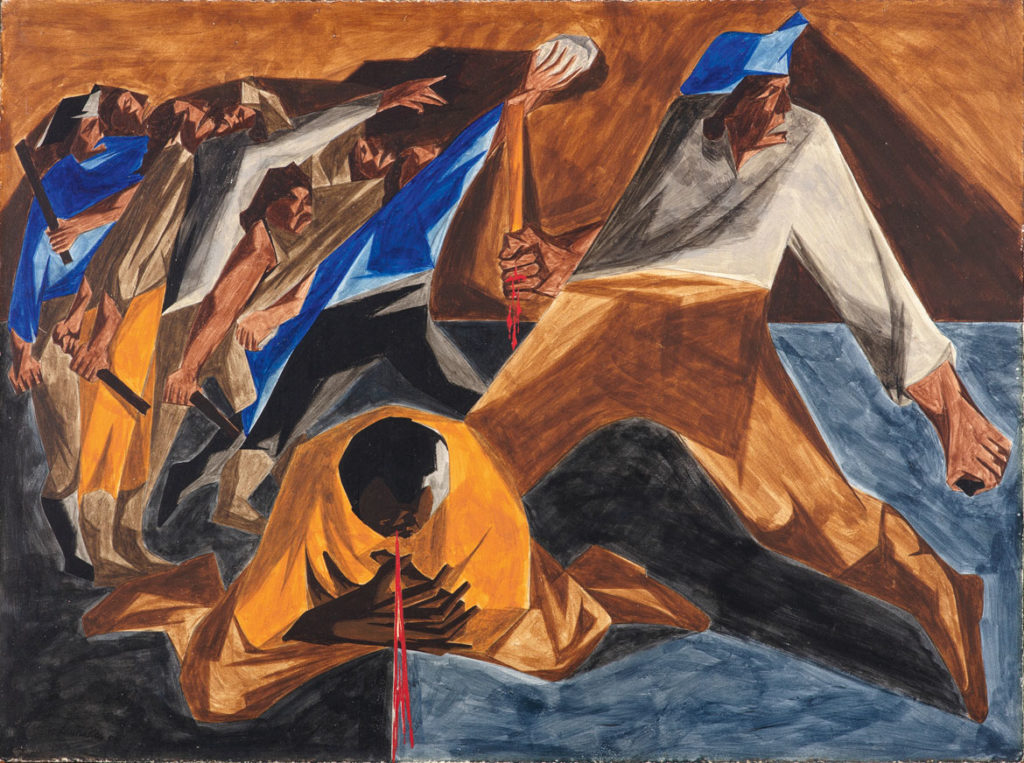
The “Struggle” series jumps through time—Crispus Attucks dying in the Boston Massacre; a laboring farmer; a bloody clash between American rebels and British Red Coats; Revolutionary era spies whispering to each other; women fighting in the war; the British surrender.
After the Revolution, Lawrence highlights the debate over drafting the U.S. Constitution; colonial explorers Meriwether Lewis and William Clark meeting (what seems to be) a Shoshone chief; American sailors captured and forced into service by the British Royal Navy (one of the actions that sparked the War of 1812); the British invasion of Washington, D.C, in 1814; and Shawnee Chief Tecumseh’s 1811 loss to Americans at Tippecanoe.
Lawrence’s American history wraps up with a failed 1810 uprising of enslaved people in Georgia and North Carolina; workers constructing the Erie Canal across New York state between 1817 and 1825; and covered wagons rolling west.
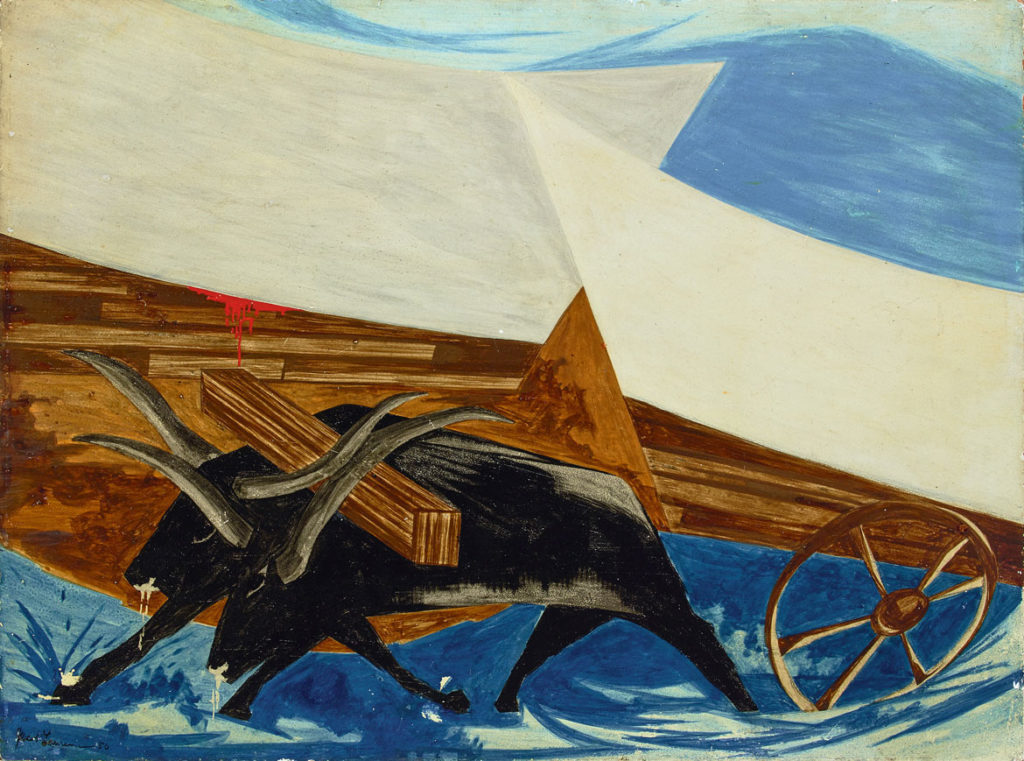
Writing history is an expression of values—a statement that this event is important enough that it must be remembered, this event is something we should continue to learn from.
Lawrence’s “Struggle” interrogates the professed American ideals of liberty, freedom and equality. At the same time, the series is an act of integration. He highlights the Black and Native American stevedore Crispus Attucks mortally wounded at the Boston Massacre, African Americans in the boats with Washington as he crosses the Delaware River, Black men among the soldiers battling the British during the Revolution, and African Americans laboring on the Erie Canal. (He also features indigenous peoples violently displaced by the United States’ growth.) As African American patriots were struggling to integrate American schools and restaurants and public transit in the 1950s, “Struggle” is an assertion that Black history is not separate from American history, rather Black history is an integral part of American history, and white Americans must see and recognize that too.
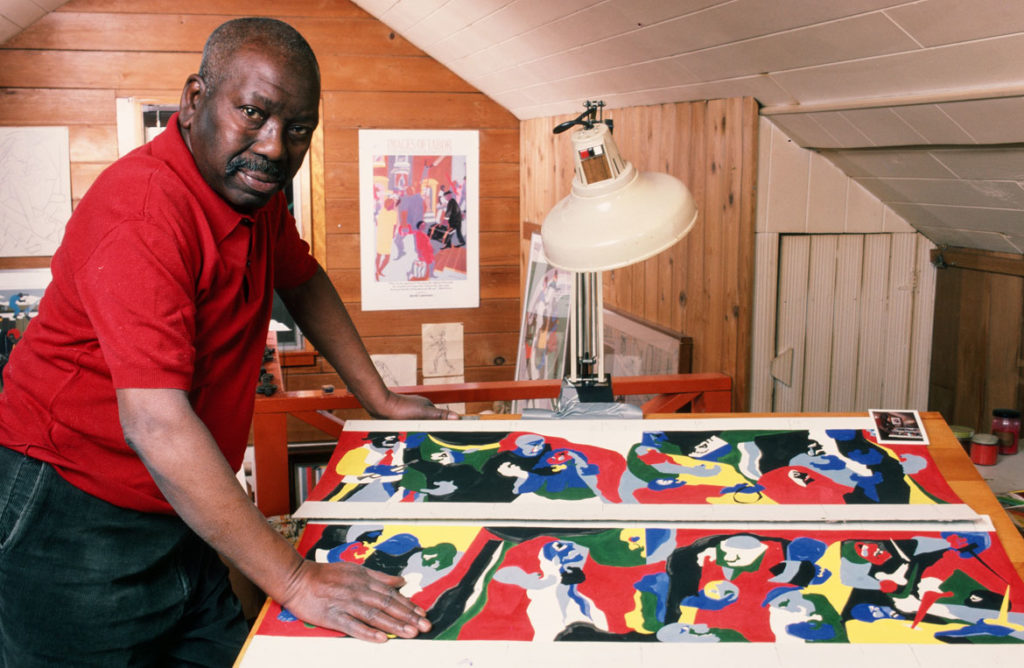
‘The Spirit Of The Events’
“Struggle” made its public debut on Dec. 28, 1956, in Lawrence’s first solo exhibition in nearly four years, and his first at New York’s Alan Gallery. The brochure described the show as the “first 30 paintings” out of a planned 60—though he would never paint more of the group. “The series is for sale as a unit only,” the gallery said.
“Lawrence’s temperas throughout are spirited, colorful, and rise above sheer realism and postery effects (into which they might so easily have fallen) by virtue of the emotion he has brought to his task and through his consistent symbolizing rather than merely representing his themes—it is the spirit of the events he has chosen rather than mere realistic representation,” Howard Devree wrote in the Jan. 6, 1957, New York Times. “Quotations from letters, documents and speeches have been selected rather than titles for the pictures and help to explain the rather exalted mood which the artist has maintained throughout—the opening words of the Constitution to accompany an interpretation of he convention, the petition of slaves for redress of their wrongs, the wintery silence of Valley Forge and the enduring figures against the snow. Such moments he has made to live again. Beginning in low key he has brightened his palette as he unfolds his story and his flatly stylized forms nevertheless have striking emotional impact.”
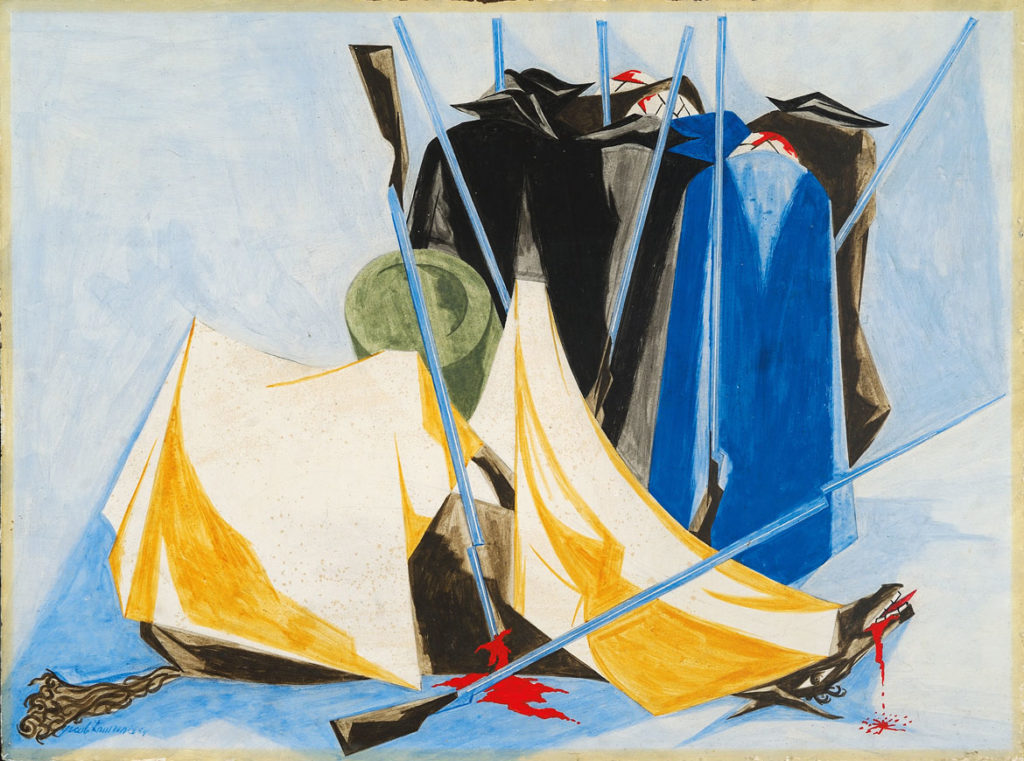
The July 1957 edition of Vogue magazine reproduced three of the “Struggle” paintings in color. Lawrence was “an eliminator,” Vogue editor Jessica Daves wrote. “He has peeled away portraiture and left in the emotion of America’s early days.”
“Struggle” was last exhibited “in its totality in 1958,” the Peabody Essex Museum reports. The entire series was sold to William Meyers of Long Island in January 1959, who proceeded to resell the panels piecemeal over the following decade.
Organizing curators Elizabeth Hutton Turner and Austen Barron Bailly and the exhibition’s coordinating curator Lydia Gordon have brought together all but five of the 30 paintings in the series at the Peabody Essex Museum. Of those missing five, they located one, but were unable to borrow for the exhibition—apparently because it is “too fragile to travel.” Three more remain missing, but they display reproductions of the artworks. One last lost painting they could find no image of—all they know is that it was titled “Spindles.”
“My themes may deal with the Negro but I would like to think of it as dealing with all people, the struggle of man to always better his condition and to move forward,” Lawrence said in the 1968 0ral history interview. “…I don’t think the Negro situation is different. It may differ in a small cultural sense, but I think all people aspire, all people strive toward a better human condition, a better mental condition generally. And if I can express that through the Negro image, I would like to think that I’m making some contribution in this area.”
If this is the kind of coverage of arts, cultures and activisms you appreciate, please support Wonderland by contributing to Wonderland on Patreon. And sign up for our free, weekly newsletter so that you don’t miss any of our reporting.



